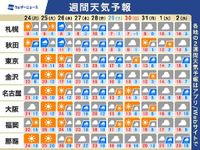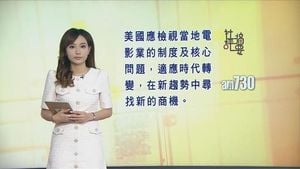On March 23, 2025, warm early summer air swept into western and eastern Japan, resulting in record temperatures across the region. Over 70 locations reported maximum temperatures surpassing 25°C, with predictions indicating that this unseasonable warmth will persist until March 28. In the coming days, temperatures are expected to hover around 20°C due to cloud cover brought by a passing pressure trough. Nevertheless, from March 25 to March 26, temperatures in the Kanto region and western Japan are predicted to rise to around 25°C, making conditions reminiscent of mid-summer.
This influx of warmth has fostered the growth of cherry blossom buds. Reports from Kochi and Kumamoto confirm that the iconic Somei-Yoshino cherry trees have begun to bloom, and as the warm weather continues, more blooming reports are expected from various regions of Japan. The anticipated maximum temperature in Tokyo for March 24 is around 26°C, contributing to ideal conditions for outdoor activities, possibly making people sweat under the sun.
During this same period, the weather is forecasted to be relatively calm, but significant rain is expected in the latter part of the week. Starting on March 27, a low-pressure system is predicted to develop as it approaches Hokkaido from the Sea of Japan, bringing widespread weather disturbances. A front associated with this low-pressure system will sweep across the Japanese archipelago by the end of March 28. Rain will likely follow due to warm, humid air funneling into the area.
The convergence of a winter-type pressure pattern on March 29 will also bring a dramatic drop in temperatures across many regions. The -6°C line at an altitude of 1500m is projected to move southward towards the Sea of Japan side of western Japan. This shift means that many areas, including Fukuoka, Osaka, and Nagoya, will likely see maximum temperatures fail to reach 15°C, with Tokyo forecasted to experience a dip to around 13°C by March 30. The forecast indicates a stark reversal to cold conditions following a period of unseasonably warm weather, potentially impacting public health with extreme temperature fluctuations.
Pollen counts are also a growing concern as the warm weather accelerates pollen dispersal. High cedar pollen counts are expected, raising alerts for individuals suffering from pollen allergies. Consequently, those susceptible are advised to take necessary precautions when going outdoors.
As the week progresses, meteorologists are warning of potential localized heavy rain and thunderstorms, primarily affecting the Pacific side from western to eastern Japan. Those living in areas with heavy snow should be vigilant about avalanches and snowmelt as the predicted rain could exacerbate conditions.
The Kanto region, particularly, is bracing for strong southwesterly winds on March 27. Transportation services may face delays as gusts are anticipated to ramp up due to the developing low-pressure system. Following the front's passage, conditions will further deteriorate, resulting in increased wind speeds and possibly dangerous weather conditions.
Given these forecasts, residents are urged to stay informed and plan accordingly, ensuring they remain safe amid what is shaping up to be a tumultuous weather week. As spring burgeons in Japan, the stark contrast of the shifting weather reminds everyone of the region's unpredictable climate, reinforcing the need for readiness.
In conclusion, as temperatures fluctuate between early summer warmth and late winter chills, it will be crucial for individuals to monitor weather updates closely. Cherry blossom enthusiasts will certainly welcome the bloom across various regions; however, it’s wise to stay aware of impending weather challenges.






